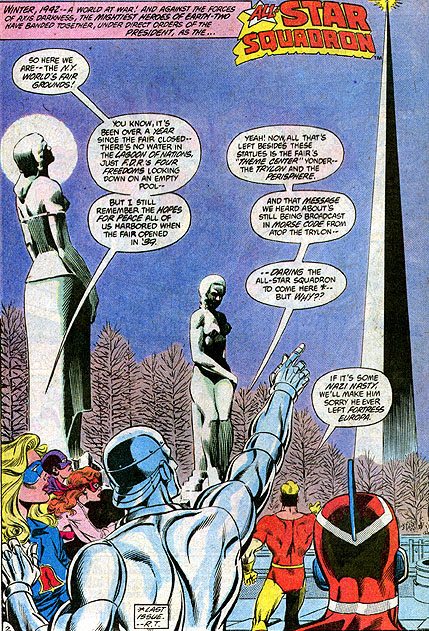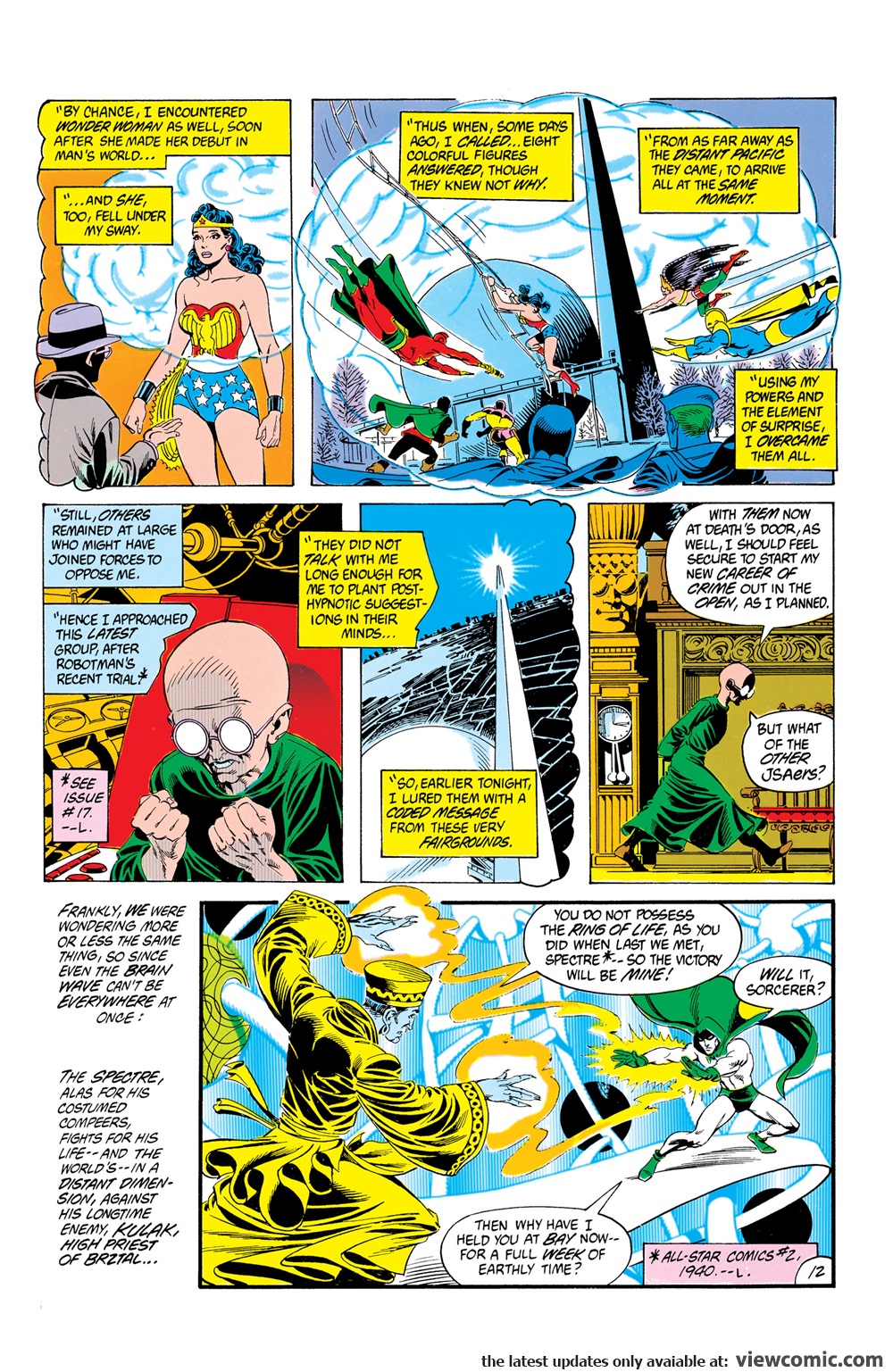Writer: Roy Thomas
Art: Rich Buckler, Jerry Ordway, Arvill Jones and others
DC Comics, 1981-1987
It is hard as a fan of Roy Thomas’ grand revisionist work, All-Star Squadron, to believe that it has been 40 years since the series preview appeared in Justice League of America #193 (August 1981). The events of All-Star Squadron took place a little more than 40 years before that, beginning with the Japanese attack on Pearl Harbour on 9 December 1941.
All-Star Squadron revisits the characters of the Golden Age of Comics. The title was Mr Thomas’ very extended love letter to the comic books of his youth, and the anachronisms of the day.

These titles were put together with haste by publishers keen to ride the commercial wave of the brand new and exciting superhero genre in the late 1930s and early to mid 1940s. As 1940s editor Sheldon Mayer put it in a letter to the editor which appeared in All-Star Squadron #25, “The object of the game was to produce all the stories we needed in time for our deadlines”. Accordingly, some of the stories were not very good, historically inaccurate, or were just plain weird (members of the Justice Society being send in small rockets to various planets of the Solar System wherein they encountered goofy alien races).
Mr Thomas decided that a substantial part of his role was to fix things up so they made sense.
So, when the sorcerous Dr Fate lost his magical powers along with the lower half of his golden helmet, Mr Thomas explained this as the character’s unwillingness to be no longer beholden to Nabu, a cosmic Lord of Order who resided within the full-length version of the magical helm.
When the powerless brawler called The Atom (named for his diminutive height) gains super strength and changes the look of his costume without explanation, Mr Thomas creates an encounter with a new pathos-ridden character called Cyclotron, who imbued The Atom with transformative radiation during a mismatched fight.

When the Justice Society of America go on missions improbably leaving one of the most powerful of their number, Wonder Woman, behind to record their adventures in role of secretary solely because of her gender, Mr Thomas gives us insight into her thinking (resigned bemusement).
And when Starman violently reconquers the Aleutian Islands following Japanese invasion, Mr Thomas explains that as a psychotic dream induced by the villainous Brainwave.
Mr Thomas also explains why the mightier of the superheroes do not fly into Nazi Germany and abduct Adolf Hitler in an effort to end the war. As Mr Thomas noted in his “epilegomena” in 1986’s Last Days of the Justice Society Special, “I had to fit my stories and my heroes into a world at war – without the more powerful of those heroes immediately winning (or at least unhistorically affecting) that war.” In All-Star Comics #11 (1942), the all-powerful Spectre blithely notes, “As a ghost, I’ll keep just as busy on the home front – there’s plenty of work to do!”. The Spectre instead could have stopped the Axis advance across Europe and Asia in an hour. But he did not.
A 1977 comic written by veteran DC Comics writer and editor Paul Levitz had Hitler wield the magical Spear of Destiny, the lance which purportedly pierced the side of Christ as He was nailed to the cross. Mr Thomas ran with this in All-Star Squadron #4. The Spear of Destiny can bend the will of those characters with magic-based powers such as Green Lantern, Wonder Woman, Dr Fate, Captain Marvel, and just for good measure but with no real explanation for it, Superman.

A superhero invasion of Japanese territory to avenge the attack on Pearl Harbour is quickly thwarted when the powerful half of the nascent All-Star Squadron turn on the rest. It ends in a desperate fight when Superman, Green Lantern and Wonder Woman come into range of the Spear. The superheroes realise that they can do nothing about the rapid military advances of the Axis powers. Those heroes affected by the Spear’s magic had to stand down or risk becoming pawns of the Axis powers. (Writer Kieron Gillen’s 2013 title Uber is about a grim World War two counter-attack by super-powered Nazis seems to be inspired by this sequence). And later, Captain Marvel, brought into the story from an alternative dimensional Earth, falls under the Spear’s sway.)
It was a nice way of dealing with the conundrum. Historical accuracy of the war and its outcome was thereby preserved through a plot device with anchor relating to a bizarre fact, that Hitler was obsessed with religious relics.
So, much of the title was therefore concerned with a massive editorial task: revisiting the 1940s and answering all of the questions Mr Thomas as a young man must have had as he read these deeply flawed stories.
But Mr Thomas was not just engaged in a gargantuan editorial prospect. He was (and is) also a talented writer. From the perspective of quality rather than history, the throw-away characters of the period are revitalised with personality:
a. Johnny Quick is revealed as a hothead bereft of emotional intuition, and a barely-concealed inferiority complex to speedster The Flash;

b. Robotman is clinically depressed: his human brain is implanted in a steel body and he is completely incapable of living a normal life.

c. A new character, Amazing Man, experiences 1940s racism: he discovers being an Olympic gold medallist counts for nothing in 1940s New York.
d. Steel (a character created in the 1970s but retrofitted into Golden Age continuity) is likewise haunted by his past.

e. Another almost forgotten character from the archives, The Tarantula, is a helpless spectator to the death of the Sandman’s romantic partner, Dian: like so many other people at the time who are witness to violent death, he carries on a more sombre man. The Tarantula is a quiet rival to Johnny Quick to the affections of Liberty Belle, the team’s leader. Liberty Belle is a world-famous, attractive reporter, a blonde Lois Lane. She is recognised by US President Franklin Roosevelt as capable and intelligent, and able to command the combined might of America’s superheroes.
None of this was apparent when the characters were first published. They were quick replicants of Superman, the most successful of the superhero genre at the time. Mr Thomas took the cardboard cut-outs and made them meaningful. As a letter-write noted in All-Star Squadron # 17, “I… get the feeling that the characterisation in All-Star Squadron is not talking down to my adult sensibilities.”
The title has not dated at all, because it is a period piece. Comic book heroes in the early 1940s dressed in a certain archaic way, spoke in a certain archaic way (“Say, “, and “Remember Pearl Harbor!”), and acted in a certain, sometimes misogynist or and even racist way when referring to Germans or Japanese.
But they certainly did not swear. The heroes use guns, but they shoot sleeping gas, grappling hooks, or gooey web. And there is no overt sex.

There are however lurking sexual aspects to the characters which would not go unnoticed in mainstream superhero comics today. These include Starman’s phallic Cosmic Rod (in Last Days of the Justice Society, Starman refers to it guilelessly as “throbbing” with power), Wonder Woman’s loss of powers when she is submissively bound around the wrists by a man, and the Atom’s bondage mask and bare legs.
The dress-like robes worn by villains such as Brainwave, Kulak, and Dr Zodiak are also breezed through without comment. Interestingly, although the heroes wear tight-fitting circus performers’ attire, none of them are transvestite. Only male villains wear gowns. The male characters instead all have heroic physiques and the female characters are all beautiful (something we discussed in a previous review https://worldcomicbookreview.com/2020/06/22/the-rocketeer-v-all-star-squadron-a-comparative-review/).
Jerry Ordway was the inker, and by issue #18 when Rich Buckler left for other projects at DC Comics, the penciller as well. Mr Ordway was at his ascendency and his art was an undeniable drawcard for the title. The panels are clean – Mr Ordway has sparing use of cross-hatching or other forms of shading. As a letter-writer noted in All-Star Squadron #5, Mr Ordway’s and fellow artist Rich Buckler are “simple and concise… and [give] the reader a sense of ’40s atmosphere, a sense of the tempo and times of the era”. The female characters in particular have pin-up looks and period hairstyles. Perhaps it is fairer to say that there is sex, but it is 1940s sex.

What was missing from the story? First, the Second World War was as the name suggests as global conflict. But the characters are almost exclusively either American, German, or Japanese. It is not even an Anglophone perspective of the war: Aside from the British superhero Shining Knight and brief appearances from UK Prime Minister Winston Churchill, there are no Europeans at all, let alone Russians (the Soviet Army took the brunt of the German war effort, and notwithstanding the fearsome death toll beat the other allies to Berlin) or Chinese (who fought the Japanese longer than anyone).
Mr Thomas is an American who grew up reading American superhero comics, and at that time the genre was exclusively American. It is therefore no surprise, but it is a little disappointingly narrow.
Second, the pace of the story is glacial. As one letter writer noted, if it continued at its pace for the duration of the war, the series would not have been finished until the 2020s. (Notwithstanding that, the sheer amount of action ensured that while the plot rambled, the stories never grew boring, and they still convey a sense of fun.)

Never revealed is the heroes’ reaction at winning the war. We know from The Last Days of the Justice Society how the core group of the Justice Society reacted when Roosevelt died, but not the other members of the All-Star Squadron (especially Liberty Belle, who was depicted as having a strong personal relationship with the president).
Similarly, we do not whether they were elated by the surrender of Japan, troubled or outraged by the atomic bomb strikes on Hiroshima and Nagasaki, nor which of them did not survive.
Only one died in combat in the course of the series – the obscure Red Bee.

But Mr Thomas in The Last Days of the Justice Society posits a lost reality where in 1945 Hitler uses the Spear of Destiny to destroy the Earth. As part of a desperate mission on Hitler’s bunker, Starman is shot in mid-air, and the Flash is seriously wounded while trying to rush Starman to hospital. Mr Terrific and The Atom are both machine-gunned down as they approach the bunker’s entrance, and Dr Mid-Nite is killed during a melee inside the bunker. Sandman takes a glancing bullet to the forehead which impairs him – he then takes a rearguard action to fend off Nazi reinforcements. Only Batman, Hawkman and Wildcat make it through… but too late to stop Hitler from unleashing the Apocalypse.

But as the plot rolls on, it becomes clear that this (sort of) did not come to pass. And the wartime fates of many other All-Star Squadron members are mostly left unknown until explored decades later in Geoff Johns’ revived Justice Society series (a title Mr Thomas did not approve of).
All-Star Squadron ended in March 1987 with 67 issues and three annuals. It lasted longer than the war itself by a year.
Strangely, given it was a foundation stone for a number of titles over the years (Young All-Stars, Infinity Inc., Justice Society, Starman, The Unholy Three, and Kingdom Come), it is odd that publisher DC Comics has never thought to collect it as a series of volumes.
This was not the first time we have looked back at this title – see https://worldcomicbookreview.com/2020/06/22/the-rocketeer-v-all-star-squadron-a-comparative-review/ and https://worldcomicbookreview.com/2018/08/15/goodbye-to-the-good-war-a-slow-decline-of-comic-books-based-in-world-war-two/ and we suspect it will not be the last.
Happy 40th birthday, All-Star Squadron.

